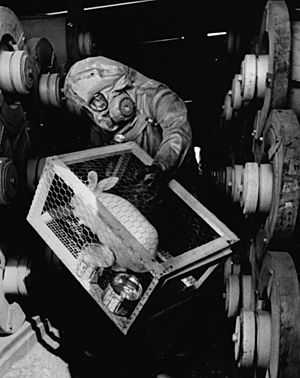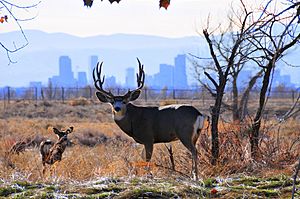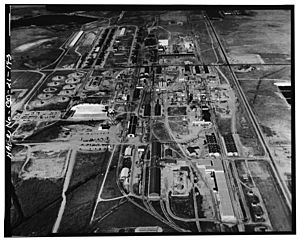Rocky Mountain Arsenal facts for kids
The Rocky Mountain Arsenal was a place in Commerce City, Colorado, near Denver, where the United States made chemical weapons. It was built in December 1942 and was run by the United States Army for many years. Local people often worried about it. The Arsenal closed in 1992. Today, much of the area is a protected place called the Rocky Mountain Arsenal National Wildlife Refuge.
Contents
History of the Arsenal
After the attack on Pearl Harbor, the United States joined World War II. The U.S. Army needed a place to make chemical weapons. They bought about 20,000 acres (81 square kilometers) of land north of Denver. This spot was great because it was close to Stapleton Airport and its natural features made it harder to attack.
The Rocky Mountain Arsenal made dangerous chemicals like mustard gas, napalm, white phosphorus, lewisite, chlorine gas, and sarin. In the early 1960s, the Army started renting out parts of the Arsenal to private companies. These companies made pesticides.
By the early 1980s, the site was chosen as a Superfund site. This meant it needed a big cleanup because of pollution. In the mid-1980s, wild animals, including rare species, started moving into the area. This led to the land becoming a protected park.
How Laws Helped the Cleanup
The environmental movement grew in the U.S. in the 1960s and 1970s. In response, Congress created a law in 1980 called the Comprehensive Environmental Response, Compensation, and Liability Act (CERCLA). This law is usually called "Superfund." Superfund put a tax on chemical and oil companies. It also gave the government power to act when dangerous materials were released.
After 42 years of making chemicals, the U.S. Army began checking how much pollution was at the Rocky Mountain Arsenal (RMA) in 1984. The site was put on the National Priorities List (NPL). This list names the most polluted places in the United States. The RMA became a top priority Superfund site.
Things changed even more when the Army found bald eagles, which were an endangered species, living there. After checking the eagles and finding them healthy, groups worked to turn the RMA into a wildlife refuge. In 1992, Congress passed the Rocky Mountain Arsenal National Wildlife Refuge Act. This law said that most of the cleaned-up land would be managed by the Federal Fish and Wildlife Service. The Army would still own any parts that were still polluted.
There were some disagreements between the U.S. Environmental Protection Agency, the State of Colorado, the Army, and the chemical companies. They all worked together to clean up the site. The State of Colorado even took legal action to decide who was in charge of the cleanup and who would pay for the damages.
Why This Location Was Chosen
The Arsenal's location was picked for several reasons. It was far from the coasts, making it less likely to be attacked. There were enough people nearby to work there. The weather was good for outdoor work, and the soil was right for the project. Being close to Stapleton Airport also helped with transportation.
In 1942, the U.S. Army bought almost 20,000 acres (81 square kilometers) of land for about $62.4 million. This land was used to make weapons for World War II. Some of this land also held a prisoner of war camp for German soldiers. Later, part of the land was given to the city of Denver as Stapleton Airport grew. A special channel was built from the High Line Canal to bring water to the Arsenal.
What Was Made There
The Rocky Mountain Arsenal made both regular and chemical weapons. These included white phosphorus (used in grenades), napalm, mustard gas, lewisite, and chlorine gas. It was also one of the few places that stored Sarin gas, a very dangerous nerve agent. Making these weapons continued until 1969. Rocket fuel for the Air Force was also made and stored there.
From the 1970s to 1985, the RMA was used to destroy old weapons and chemical items. At the same time, from 1946 to 1982, the Army rented out parts of the Arsenal to private companies. These companies made pesticides. Major companies like Shell Oil Company used the site. The military kept the right to take over these facilities again if there was a national emergency.
The Deep Injection Well
The RMA had a deep injection well built in 1961. It was drilled down more than 12,000 feet (3,671 meters). This well was used to inject liquid waste deep underground. The well was sealed to prevent the waste from reaching the surface or clean groundwater. The Army stopped using the well in February 1966 because the injected liquid caused a series of earthquakes in the area. The well was permanently sealed in 1985.
Environmental Concerns

In 1984, the Army started a detailed check of the pollution at the site. This was part of the Superfund law. In 1987, the RMA was added to the National Priorities List of Superfund sites. Since 1985, the main goal at the RMA has been to clean up the site.
What Polluted the Site?
The main pollutants included pesticides, chemicals used to make products (like chlorinated benzenes), heavy metals, chemical warfare materials, and their breakdown products. Other things found were ordnance (like incendiary bombs), asbestos, and PCBs. Today, Colorado considers it a hazardous waste site.
Water Pollution Underground
Water underground (the alluvial aquifer) became polluted because waste was dumped into unlined ponds. From 1943 to 1956, the Army and Shell dumped waste into these ponds. This pollution reached the South Platte River outside the Arsenal. Farmers nearby complained that their crops were damaged by water pumped from the shallow ground.
In response, the Army built a lined pond for waste in 1956. In 1961, they built the 12,000-foot deep injection well for waste disposal, which later caused earthquakes in Denver. In 1975, Colorado ordered the Army and Shell to stop dumping pollutants and to control the polluted groundwater. They installed a system that treated about 1 billion gallons of water every year. The deep injection well closed in 1985, and the main waste pond (Basin F) closed in 1988.
Even with cleanup efforts, the water in and around the Arsenal may never be fully clean. A large amount of underground water (about 65 million cubic meters) cannot be used for drinking.
Harm to Wildlife
Studies found that wildlife was harmed. The U.S. Fish and Wildlife Service estimated that at least 20,000 ducks died over 10 years in the 1970s. Dead ducks had high levels of a chemical called Dieldrin. Many other mammals and birds were found dead. Some may have had fewer babies or birth defects.
Safety for People Living Nearby
Because the RMA was a Superfund site and needed huge cleanups, many people living nearby worried about their health. In 2017, Colorado sued the U.S. government to gain more control over the polluted areas. Even though the main cleanup finished in 2010, soil and groundwater are still checked every five years. Rules about using well water, building homes, eating fish or game from the Arsenal, and farming will stay in place forever, until more research is done.
Drinking Water Safety
Many nearby neighborhoods now get clean tap water from other parts of Adams County. This is because of possible pollution from wells near the Arsenal. Small amounts of a chemical called 1,4-dioxane have been found in some drinking water samples. While there's no national standard for this chemical, Colorado has a way to treat it.
Soil Safety
As part of the cleanup, much of the top 10 feet of soil was removed from the site. This soil is now stored in special hazardous waste landfills. Some polluted soil remains at the Rocky Mountain Arsenal, but it is kept safely in special basins and structures.
Air Quality Safety
During the cleanup, people worried about air pollution from the dangerous materials. The Colorado Department of Public Health and Environment set up air monitors around the RMA. Over decades of cleanup, these monitors showed that no Arsenal chemicals were released into the air at unsafe levels for public health.
Health Studies
Concerns about health and farming near the Rocky Mountain Arsenal led to many legal and political battles. Dangerous chemicals from a waste pond (Basin F) worried the public. A medical monitoring program (MMP) was set up in 1996. One goal of the MMP was to assure the community that the cleanup was working. It included checking air quality, cancer rates, and birth defects. Air quality checks started in 1997 and continued until 2009.
Studies on birth defects looked at existing records from 1989 to 2009. The studies compared birth defects before and during the cleanup. They looked at things like heart defects and skeletal problems. The studies found no significant increase in birth defects during the cleanup period compared to before.
In short, there is no current proof of health problems linked to the Arsenal. The Colorado Department of Public Health and Environment found no increased risk of birth defects. Another study on cancer rates also found no strong proof of increased cancer risk for people living near the Arsenal. Studies at Colorado State University also found no increased risk of Arsenic, Mercury, or nerve damage in communities within 15 miles of the RMA.
Cost of Cleanup
Many projects have tried to clean up the polluted groundwater at the Arsenal. For example, levels of a chemical called DIMP dropped from 640 parts per billion (ppb) in 1987 to 55 ppb in 1989 in one area. Another area saw levels drop from 138 ppb in 1985 to 6.7 ppb in 1989.
It's hard to know the total cost of cleaning up the site. Here are some examples of what was spent on groundwater cleanup:
- North boundary groundwater treatment system (1979–82) – $4.3 million
- Irondale groundwater treatment system by Shell (1981) – $1.1 million
- Deep well closure (1986) – $2.5 million
- Removal of 76,000 drums of waste salts (1986) – $10.5 million
- Water treatment for public drinking water (1989) – $23.1 million
- Removal and containment of 10.5 million gallons of Basin F liquids and sludges (1989) – $42 million
These direct costs add up to about $111 million, not including ongoing maintenance. Other projects cost an additional $151.2 million. One estimate in 2004 said that removing pesticides from the groundwater and soil at the RMA could cost about $2 billion. If all groundwater were to be made safe for drinking, it could cost $500 million each year.
It's very hard to figure out all the direct and indirect costs of the pollution. There have been damages to farms, like lost livestock and crops. Pollution also affects public health and nature, like bee poisonings and harm to wild birds. While direct costs are known, the indirect costs, like long-term health effects or environmental damage, are much harder to estimate. For the Rocky Mountain Arsenal, the total indirect cost was not even estimated.
Rocky Mountain Arsenal National Wildlife Refuge Act

In 1986, people found that because humans had left the area, it had become a natural park. A group of bald eagles, which were an endangered species at the time, was found living there in winter. The U.S. Fish and Wildlife Service found over 330 types of wildlife at the Arsenal. These included deer, coyotes, white pelicans, and owls.
The Rocky Mountain Arsenal National Wildlife Refuge Act was passed in October 1992 and signed by President George H. W. Bush. It said that most of the site would become a National Wildlife Refuge once the environmental cleanup was finished. The Act also allowed parts of the Arsenal to be managed as a refuge even before the cleanup was complete. Finally, it allowed some land to be used for road expansion and 915 acres (3.7 square kilometers) to be sold for development in Commerce City.
Since 1995, the buildings at the Arsenal have housed the National Eagle Repository. This office collects the bodies of all dead Golden and Bald Eagles in the nation. It then provides their feathers and other parts to Native Americans for cultural uses.
In September 2010, the cleanup was considered complete. The remaining land was given to the U.S. Fish and Wildlife Service, making the refuge about 15,000 acres (61 square kilometers) in total. The Army kept two small areas: the South Plants location and the North Plant location, which is now a landfill holding remains of old buildings.
On May 21, 2011, the official visitor center for the refuge opened. It has exhibits about the site's history, from early farming to its current status.
Public Access and Activities
The Rocky Mountain Arsenal National Wildlife Refuge is open for public use. This includes community outreach and educational programs. People can visit while still supporting the cleanup efforts and the Fish and Wildlife Service's work.
Dick's Sporting Goods Park
In April 2007, Dick's Sporting Goods Park, a soccer-specific stadium, opened on part of the former Rocky Mountain Arsenal land. This land was given to Commerce City. The stadium is home to the Colorado Rapids soccer team.
Bison at the Refuge
A small group of wild bison was brought to the refuge in March 2007. This was part of the Fish and Wildlife Service's Bison Project. The animals came from the National Bison Range in Montana.


